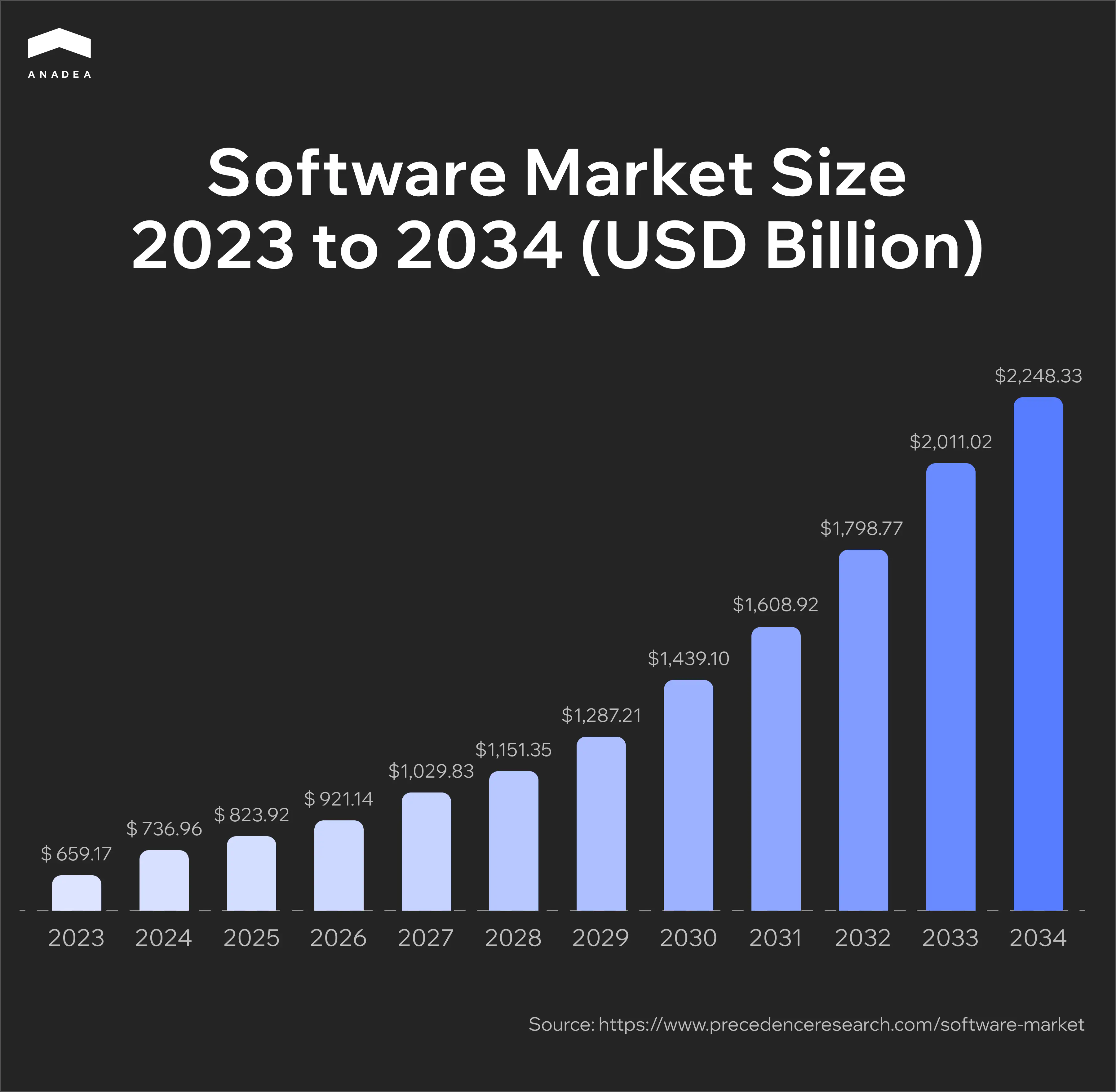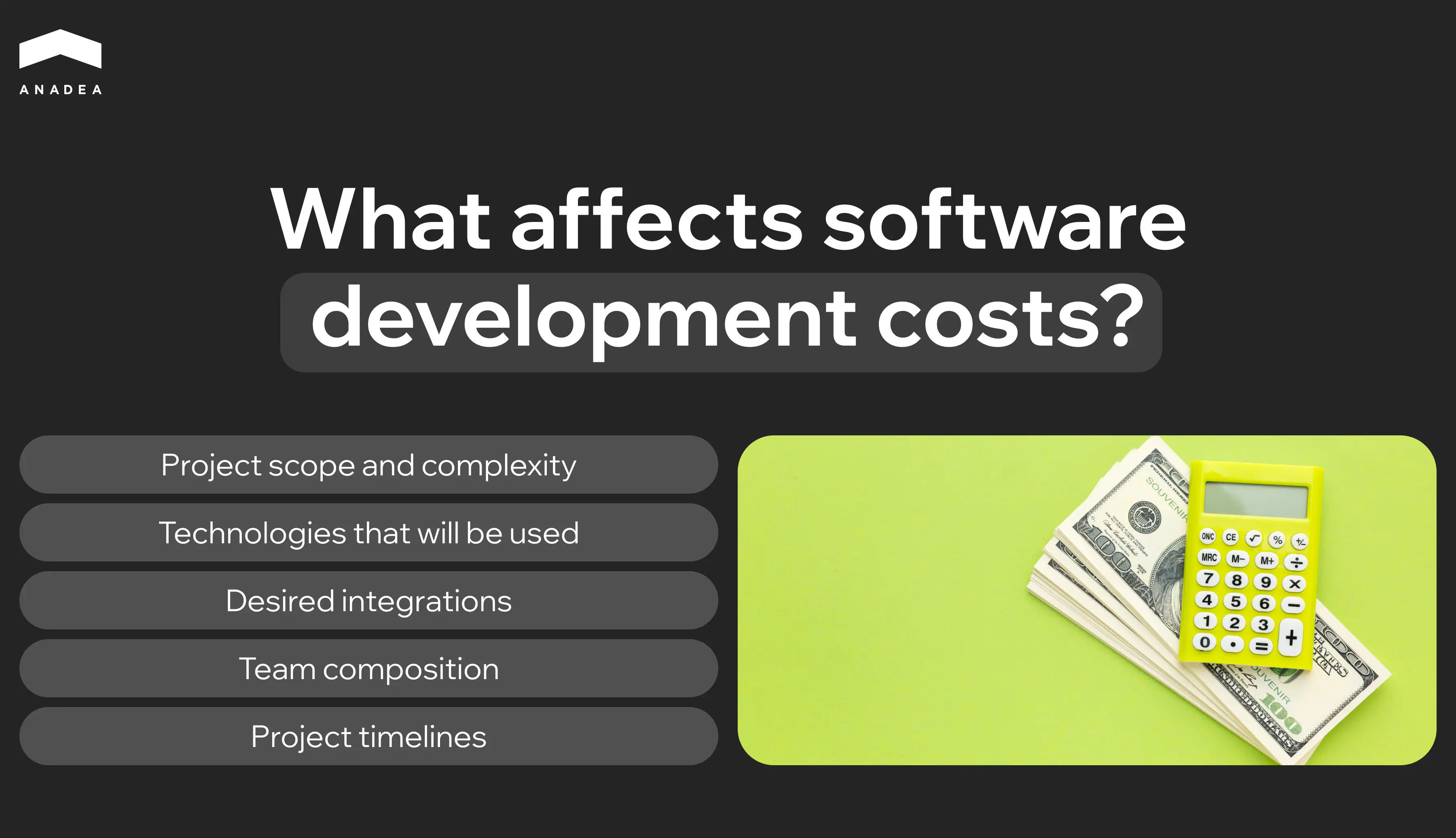What is Custom Software Development and What It Looks Like in 2025

Today, we are living in the era of digitalization. More and more new software tools are implemented in different business processes to facilitate and streamline them. Apart from that, a growing number of digital solutions are becoming an important part of our daily lives. In 2024, the global software market size was evaluated at around $736.96 billion and according to experts, it can reach the level of $2,248.33 billion by 2034. The custom software development market is projected to hit the mark of $99.09 billion in 2028, growing from $36.6 billion achieved in 2023.

But what is custom software development? And does it still really matter in 2025 when there are so many off-the-shelf solutions for a wide range of purposes and use cases?
Let’s start with some basic information and further proceed to the most significant trends that are shaping the future of the industry.
What is custom software development? Key things you need to know
This term can be defined as a process of designing, creating, deploying, and maintaining software solutions tailored to the specific needs of a particular individual, organization, or user group.
The development approaches to building off-the-shelf and custom products may be just the same. However, the main difference is related to the purposes of such solutions. Custom products are designed based on specifically provided requirements and can address unique goals, workflows, and challenges. Off-the-shelf products are typically intended for a very wide audience.
Main benefits of custom software development
- Tailored functionality. Custom software is created to align closely with the particular needs and goals of its future users. This ensures that features and workflows can match unique business processes.
- Flexibility and scalability. Ready-made products often lack the desired scalability. When you reach the allowed maximum of users, workflows, or data volumes to be processed, such solutions may demonstrate significant deterioration in their performance. Custom software is designed to evolve with the organization’s needs.
- Competitive advantage. By ordering custom software development services, you can get an absolutely unique solution. Being fully adapted to your needs, it will turn out to be much more efficient than any generic solution. Thanks to this, such software can provide your organization with a strong competitive edge.
- Integration possibilities. Custom products can be integrated seamlessly with any other tools and systems used by your organization. It will ensure smooth data exchange between your solutions, enhanced efficiency, and elimination of compatibility issues.
- Ownership. The organization that launches any off-the-shelf software typically owns it. It means that the vendor will have full control over the software use, distribution, and modification. As a result, you will depend on the vendor’s decisions related to this product. When you have your custom solution, you leverage freedom in such questions.
Despite some challenges like high initial costs or long time-to-market, custom software development services can open a lot of new business opportunities for you. That’s why when you have already found answers to questions like “What is custom software development?” and “How can I benefit from it?”, it’s time to find out the latest trends in this industry.
Trend 1. The use of AI-based tools to power custom software development
We can’t say that artificial intelligence is ready to replace software developers. This statement is completely wrong. Manual coding is still a very valuable and important skill. However, today this skill can be successfully strengthened with the help of AI.
AI-powered tools are designed to enhance the efficiency, quality, and overall productivity of the development process. They help to automate various tasks, improve decision-making, and enable more intuitive workflows. By integrating AI into the development process, companies can reduce time-to-market, lower costs, and improve software quality.
The most popular AI use cases in software development
- Code completion and generation. Some modern development tools rely on ML algorithms to assist developers by providing code suggestions and automating repetitive coding tasks. This can not only reduce the time needed for writing code but also minimize errors in it. Apart from this, AI can generate boilerplate code automatically based on specifications or requirements made in a natural language.
- NLP (Natural Language Processing) for requirement gathering. NLP tools can be used to analyze and extract essential information from various sources like documents, emails, or meeting notes. This significantly reduces the time spent on manually collecting and interpreting business requirements.
- Threat detection. AI-powered tools can also detect vulnerabilities in the code and flag security risks. These tools provide real-time alerts and suggest actions that will help to mitigate the existing risks during development.
Trend 2. Democratization of software development
Professional programmers need to spend years learning to code. But what if we say that today practically every person without any specific tech background can create business apps and workflows? This has become possible thanks to the introduction of no-code and low-code platforms with visual drop-and-drop interfaces. The idea is that to create an app, users need just to choose any of the available templates and customize them with ready-made UI components from the platform’s library.
Of course, in reality, this process can be much more complicated. And to create some functionality or integrate some third-party tools, users still need to implement manually written code.
Moreover, when you rely on such no-code and low-code solutions, you should understand that you won’t have such freedom and flexibility that are typical for custom development from scratch.
Nevertheless, these platforms can help you optimize your software development budgets. First of all, as even non-tech users can interact with such tools, you can reduce your reliance on the expertise of professional developers. Secondly, with this approach to creating apps, you can get a ready product in a couple of days (and sometimes even hours), instead of weeks and months.
These platforms are becoming more and more advanced today, which allows users to build even rather complex enterprise-level systems with their help. This may sound very appealing. However, before opting for this development method, you need to carefully evaluate all pros and cons given your specific requirements.
Trend 3. The growing role of UX/UI design
UX and UI design have become critical factors in the success of custom software solutions. Today a great product isn’t just about functionality. It is also about how users interact with it and how it makes them feel. Nowadays users demand more intuitive and visually appealing applications and this fact can’t be ignored.
Modern software development increasingly emphasizes user-centric approaches. How to implement them? We strongly recommend you conduct user interviews, surveys, and usability testing to collect valuable insights. Understanding user pain points and creating interfaces tailored to their needs have to be a primary goal for your team.
It’s important to think about the accessibility of your solutions for all users, including those with disabilities. Color contrast, scalable text, captions and transcripts, sound alternatives, and voice controls are among the features that can increase inclusivity.
Also, do not forget that an engaging and user-friendly design can help to distinguish a product in crowded markets. When people just start familiarizing themselves with your solution, design is the first component that they will evaluate. Let’s be honest we all judge a book by its cover, at least when we see it for the first time in our lives.
Apart from this, take care of consistency in design across all your platforms and touch points. Seamless cross-platform experiences have become a standard expectation. Moreover, it can also boost your brand awareness and recognition.
Ready to transform your ideas into a tailored software solution?
Trend 4. Greater focus on cybersecurity
Cyber threats become more sophisticated and frequent. Therefore the need for robust cybersecurity is one of the growing trends in custom software development. Organizations now fully recognize that protecting sensitive data and ensuring software integrity are as important as functionality and usability.
Cybersecurity best practices
- Encryption and data protection. Today it is important to encrypt sensitive data at rest and in transit. It can be done with the help of such protocols as TLS 1.3 or AES-256. You can also implement data masking and tokenization for extra protection.
- Authentication and authorization. Multi-factor authentication (MFA) has already become a standard. Just a password is not enough to verify a user’s identity. You can also ask people to use their biometrics for verification or one-time codes that they will receive on their emails or mobile phones. If you have a big business system, it will be sensible to implement role-based access control. It will ensure that all users only have access to the resources they need.
- Regular security testing. Your team should conduct penetration testing to simulate real-world attacks and uncover possible vulnerabilities before making your product available to users. You need to be ready for as many risks as possible. But it won’t be enough just to test your solution once before its launch and forget about it. It is vital to perform security audits and compliance checks periodically.
- Secure APIs and integrations. You should protect all APIs with rate limiting, authentication, and authorization measures. Moreover, don’t ignore the necessity to validate all input data to prevent injection attacks.
- Incident response planning. Also, develop a comprehensive incident response plan in advance. It will help you to quickly address breaches or attacks. Make sure that your team is always ready to take the required measures.
Trend 5. Increasing popularity of cloud-native development
Cloud-native development presupposes building applications specifically designed to run in cloud environments. This process includes using specific technologies like containers, microservices, and Kubernetes. They allow developers to build software that is scalable, portable, and resilient.
Key principles of cloud-native development
- Microservices architecture. Applications are broken down into smaller, independent services. This not only makes it easier to support and modernize apps but also increases their security. If something happens to one of the microservices, all others won’t be affected.
- Containerizing. According to this principle, apps and their dependencies are packed in lightweight, portable units (containers). As a result, different functionalities are separated from hardware dependencies and other pieces of software. This makes the development process faster, more efficient, and more secure.
- Dynamic orchestration. Modern tools like Kubernetes help to automate the deployment, scaling, and management of containers.
- DevOps and CI/CD. Continuous Integration and Continuous Deployment ensures faster updates and improved collaboration on development projects.
Benefits of cloud-native development
- Faster processes. Continuous delivery pipelines and modular microservices accelerate development cycles.
- Improved productivity. Developers can focus on building features without dealing with infrastructure complexities.
- Global reach. Cloud apps can be deployed across multiple regions. This provides low-latency experiences to users all over the world.
- Enhanced collaboration. Cloud-native workflows promote collaboration between development and operation teams.
- Future-proof software products. Cloud-native designs easily adapt to emerging technologies like AI, IoT, and edge computing.
Trend 6. Demand for industry-specific software solutions
The demand for industry-specific solutions is driving a shift in the software development ecosystem. Developers are increasingly required to have domain expertise in addition to technical skills. Moreover, quite often industry specialists are engaged in the development process. This trend ensures that the apps not only meet functional requirements but also align with strategic goals and industry expectations.
Benefits of building industry-specific apps
- Improved operational efficiency. Customized workflows and automation reduce manual tasks. This allows teams to save time and resources.
- Enhanced user experience. Solutions designed with industry users in mind lead to higher adoption rates and user satisfaction.
- Better ROI. Tailored solutions often deliver higher returns by directly addressing critical business challenges.
- Streamlined compliance. Built-in compliance features minimize risks associated with regulatory violations.
- Competitive advantage. Businesses can differentiate themselves by offering unique capabilities or better service enabled by custom software.
Given all this, more and more companies prefer industry-specific solutions to generic apps. For example, for a medical center, it will be always much more feasible to implement a healthcare ERP system than a similar solution developed for a very wide group of users.
Trend 7. Wider adoption of DevOps practices
The demand for faster, more reliable, and scalable software solutions is on the rise. With this, it comes as no surprise that DevOps practices continue to evolve to help companies meet their goals.
The DevOps methodology brings development (Dev) and operations (Ops) under one roof. After its introduction, it has greatly transformed how custom software is built, tested, deployed, and maintained.
This approach bridges the gap between different teams and enables them to better understand the specificity and pain points of each other’s activities. For example, thanks to this, software developers can realize the key factors that have a negative impact on product delivery timelines.
What is changing in the DevOps approaches today? Teams embrace advanced automation, integrate security at every stage of the development process, and introduce emerging technologies in their processes.
All this has undeniable benefits for the industry in general. Automation and continuous testing ensure custom solutions are more robust and reliable. This has a positive impact on the software standards in general. Moreover, early issue detection and efficient resource management, which are typical for DevOps practices, lower costs over the software lifecycle.
Trend 8. Implementation of emerging technologies
The use of emerging technologies like blockchain, IoT, and AI helps to significantly expand the range of apps’ use cases and issues that they can efficiently address. As these technologies mature, their integration into custom software solutions is becoming more and more common.
Blockchain
It is a decentralized, distributed ledger technology, which is mainly associated with cryptocurrency. However, its use cases are not limited to this domain. This technology has found applications in various industries and now it can fully revolutionize how data is managed and shared.
On blockchain networks, all data is encrypted and remains immutable. Moreover, such networks can guarantee great transparency as all users have access to the same version of the ledger. Apart from this, the implementation of blockchain-based smart contracts can play a significant role in automation. Such contracts are executed without manual intervention when certain conditions are met.
Internet of Things (IoT)
IoT allows for connecting devices into networks to ensure real-time data exchange between them. Today IoT devices have become widely adopted in industries like healthcare, manufacturing, and smart cities, where the reliance on the most accurate data is crucial.
AI
AI enables software to learn, reason, and make decisions, resulting in smarter, more efficient, and user-centric applications. As we’ve already mentioned in this article, AI can enhance the development process. But it can also enhance software solutions and enable entirely new functionalities. That’s why it is quite natural that the demand for AI development services is rising.
For instance, AI is widely used in predictive analytics. Algorithms can analyze historical data to predict future outcomes. Moreover, thanks to AI, businesses can deliver highly personalized solutions to their customers as artificial intelligence can tailor user experiences based on individual preferences and behaviors.
Trend 9. Cross-platform development
Cross-platform development is one more approach on our list that helps to reduce development time, lower costs, and reach a broader audience across different platforms. It allows developers to create applications that work on multiple operating systems (OS) such as iOS, Android, Windows, and more, using a single codebase.
With a single codebase, developers can roll out apps to multiple platforms simultaneously. This results in a quicker launch time compared to building separate native applications.
Maintaining and updating a single codebase simplifies bug fixes, security patches, and feature updates. Changes made in the code reflect across all platforms, making it much easier to manage the app modernization.
Trend 10. Sustainable software development
This approach focuses on app development that minimizes environmental impact and promotes long-term viability. It encompasses strategies to optimize energy use, reduce waste, and enhance the overall efficiency of software applications. This trend involves both the development process and the operational aspects of software applications, including their deployment, usage, and lifecycle.
Key aspects of sustainable custom software development services
- Energy efficiency. This method prioritizes energy-efficient algorithms, code optimization, and minimizing the resource consumption of software products. The more efficiently apps run, the less energy they consume.
- Green coding practices. This term refers to writing software that performs the same tasks with fewer computational resources.
- Optimizing infrastructure. This approach relied on the idea that leveraging cloud services that operate on renewable energy can significantly reduce the carbon footprint of software.
- Efficient use of data. Reducing the amount of data processed, transmitted, and stored is crucial for sustainability.
- Sustainable development lifecycle. This includes designing applications that are easy to maintain, upgrade, and scale. Such a method leads to the reduction of technical debt and the need for frequent rewrites or updates that can consume more resources.
How to choose a custom software development company? Tips for 2025
With custom software development, you can leverage a lot of benefits that can bring real value to your business. However, to get all these new opportunities, you should make sure that your solution fully meets your requirements and market standards. One of the most important conditions for achieving this is having professional developers by your side. If you do not have such experts on board, hiring a reliable custom software development company will be the best idea.
The issue is that today there are too many agencies that offer practically the same (or at least very similar) custom software development services. Of course, such a situation may greatly complicate the decision-making process.

We have a couple of tips for you.
- Clearly define your needs and requirements. First of all, you should identify your business objectives, the problems you want to solve, and the features you need to have in the software. Apart from this, you should understand how much you can invest in your project and what the expected delivery timeline is. With all these requirements, you can start searching for the best team to hire.
- Look for companies that offer the necessary services. When you already know what you expect, you can understand what you need to look for. You need to analyze the technologies that each company under consideration can work with and the types of solutions that it can deliver. Where can you organize the search process? There are several approaches that are the most popular today. For example, you can rely on Google. Or you can leverage the benefits of professional platforms like Clutch and GoodFirms. On such resources, you can find detailed information about different teams and check their rankings.
- Pay attention to the business domains in which the company has expertise. Custom software development is not just a tech process. Successful realization of such projects also presupposes deep knowledge of the client’s business domain and the specific challenges of this or that market. That’s why it is also very important to analyze the portfolio of the company. This will help you to see whether the team has accumulated the required experience in your industry and whether it has already worked with any tasks similar to yours.
- Do not ignore the importance of reviews. It’s crucial to find out not only what companies can tell you about themselves but also what their clients can say about their cooperation with these agencies. That’s why we recommend you read the reviews that customers write on external platforms (Clutch and GoodFirms are quite appropriate for this). These reviews will help you better evaluate possible risks and pitfalls.
- Analyze the pricing policy and the offered terms of cooperation. Compare the pricing and engagement models (like fixed price, time-and-materials, or dedicated teams) offered by different companies to determine which aligns with your budget and project scope. It’s also vital to review the terms regarding project revisions, deliverable ownership, and confidentiality agreements. The process of cooperation should be smooth and pleasant for both sides. Do not hesitate to ask questions. You should have full information to make a well-grounded decision and choose the best custom software development company.
How much does custom software development cost? Information for 2025
The cost of custom software development greatly varies depending on several factors including the project complexity and the size of the team that will be hired.
Though there can be different approaches to calculating project costs, as a rule, the price will be related to the time that will be invested in the project realization.
To estimate an approximate cost of any project, you need to take the hourly rate of a team member and multiply it by the number of hours that the realization of your tasks will require.
At Anadea, the average hourly rate of our experts is $50. Based on our experience we can say that the cost of our custom software development services may start from $20K-$30K when clients want to build simple solutions with basic features.
However, hourly rates can vary significantly in different regions. That’s why you always need to check the situation in the labor market in advance before making up your mind regarding hiring.
When you are discussing your potential cooperation with a custom software development company and want to get project estimates, you need to provide your requirements. For example, at Anadea, we can make estimates for free.
What factors will have an impact on the final amount:

The more complex your project is, the more expensive it will be.
If you are looking for efficient ways to optimize development costs, we have a couple of practical recommendations.
- Prepare clear requirements. When you have accurate requirements for your project, you can expect that the team will be able to deliver a good product with a minimal number of iterations. When your requirements remain vague, it’s highly likely that some parts or elements of your solution will need changes again and again. As a result, it will take much more time to finish your project. But when you do your best to reduce the scope of changes, it will help to minimize costs.
- Start with an MVP (minimum viable product). The development of a basic version of your solution with essential features is a good approach for minimizing initial costs. An MVP will help you test your idea without big financial risks. When you are sure that your idea is exactly what your target users need, you can launch the product and further expand its functionality step by step.
- Leverage existing tools and frameworks. For many projects, it can be sensible to reuse existing libraries, frameworks, or open-source tools rather than building everything from scratch. This can significantly reduce development time and costs. But at the same time, you will still be able to enjoy the high quality of your product. For instance, popular frameworks like React, Django, and Laravel can speed up the development process and ensure maintainable code.
If you work with a reliable custom software development company, like Anadea, its experts will always help you find the best way to optimize costs. But at the same time, you will get a solution that will meet your requirements.
Wrapping up
The software development industry is highly dynamic. It is evolving rapidly under the influence of various external factors, including technological advancements, shifting market demands, and changing user expectations. To remain competitive with your business solutions, it is essential to stay updated on these ongoing changes and adapt to emerging trends.
Today, we can observe a great focus on personalization and enhancement of user experiences. This is achieved through intuitive, user-friendly interfaces, tailored approaches that cater to individual needs, and the integration of cutting-edge technologies such as AI, IoT, and blockchain.
To ensure the success and efficiency of your custom software solutions, it’s vital to align them with these trends.
If you’re looking for professional assistance in bringing your vision to life, do not hesitate to reach out to us. At Anadea, we are always ready to collaborate and help transform your ideas into a fully functional product. Share your requirements, and our expert development team will find the best approach to building a solution that perfectly fits your needs.
Have questions?
- It is a process that involves the design, creation, deployment, and maintenance of software customized to meet the specific needs of a user group.
- The exact cost of such services will depend on multiple factors, including the complexity of your future solution, the technology stack that needs to be used, the expected number of integrations, and the specificity of features. Moreover, to estimate your potential investment in such a project, you should also consider the size and composition of your team, as well as the geography of hiring.
- The time required to build a custom software solution is affected by several factors, including the complexity of the project, the size of the development team, and the specific requirements of the software. The development timeline can range from a few weeks to several months or even years for more complex projects. The use of supportive AI tools or no-code/low-code development platforms can significantly streamline the process as they reduce manual work.
Don't want to miss anything?
Subscribe and get stories like these right into your inbox.
Keep reading

Machine Learning in Banking: Benefits and Use Cases
Looking for smart ways to drive efficiency of banking operations? Explore the benefits of using machine learning in banking and finance in our blog post.

How SaaS Is Transforming the Healthcare Industry
Healthcare SaaS is booming with use cases, available software options, and ways to develop, customize, and deploy scalable and cost-effective solutions. More in the article->

New DevOps Trends: AIOps, GitOps, NoOps
Discover how new DevOps approaches are reshaping automation, operations, and delivery pipelines in modern tech stacks.
Contact us
Let's explore how our expertise can help you achieve your goals! Drop us a line, and we'll get back to you shortly.